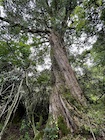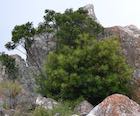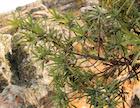Conservation Status

Podocarpus latifolius
(Thunb.) R.Br. ex Mirb. (1825)
Common names
Lusamina [Swahili], Mvavavi [Chagga], Muthengera [Kikuyu], Saptet [Kipsigis/Nandi], Sadebet [Lumbwa], Olpiripiri [Maa], Sosaita, Serti [Marakwet], Mubiribiri [Meru], Biribiriti [Samburu, Somali], Sitatet [Sebei], Msembangala [Taita], Septa [Tugen, East African yellowwood, Podo [English] (Bussmann et al. 2021); true yellowwood [English], opregte geelhout [Afrikaans] (Leistner 1966).
Taxonomic notes
Type: South Africa, Cape Province, C.P. Thunberg UPS 23780 (holo UPS). Synonymy (POWO):
- Taxus latifolius Thunb. 1800;
- Podocarpus thunbergii Hook. 1842, nom. superfl.;
- Nageia thunbergii (Hook.) F.Muell. 1876;
- Nageia latifolia (Thunb.) Kuntze 1891, nom. illeg.;
- Podocarpus milanjianus Rendle 1894;
- Podocarpus latifolius var. confertus Pilg. ex H.G.A.Engler 1903;
- Podocarpus latifolius var. latior Pilg. ex H.G.A.Engler 1903;
- Podocarpus milanjianus f. arborescens Pilg. ex H.G.A.Engler 1903;
- Podocarpus ulugurensis Pilg. 1934;
- Podocarpus milanjianus var. ulugurensis (Pilg.) Gaussen 1976 without basionym ref.;
- Afrocarpus falcatus subsp. milanjianus (Rendle) Silba 2010;
- Podocarpus latifolius subsp. latior (Pilg.) Silba 2010.
The most noteworthy synonym given here is Podocarpus milanjianus. Various authors have treated this as a distinct species, most notably Farjon (2010), as a result of which both POWO and the IUCN treat the taxa as distinct. It is not quite that simple, though, as shown by the molecular analysis of Migliore et al. (2020). That review sampled 88 specimens attributed to P. latifolius and P. milanjianus from throughout the range of the species, using other African podocarps (including Afrocarpus) as outgroups. The authors considered whole plastid genome, mitochondrial DNA regions and nuclear ribosomal DNA as evidence. They found that the two species constitute a single lineage up to about 400,000 years ago, after which there was a late-Pleistocene radiation into the species' extant distribution, traced by 11 plastid phylogroups, with all of the larger phylogroups containing samples drawn from both species. The phylogroups are widely distributed, with 2 large groups in W Africa, 3 in E Africa, and 1 in both areas (there are another 5 monotypic groups). The authors interpret these data as showing that P. latifolius was formerly very widely distributed during cooler Pleistocene climates when the Afromontane forest was more continuously distributed, with habitat fragmentation triggered by late Pleistocene/Holocene climatic variability producing largely ecotypic variation in the extant species (also see Adie and Lawes 2011, p. 84, for more discussion of the dynamic relationship between Afromontane forest and grassland). By this interpretation, Farjon's (2010) view of P. latifolius as a large forest tree of low to montane elevations, and P. milanjianus as a small tree widely distributed at montane to subalpine elevations, appears as an ecotypic rather than a taxonomic distinction. It is also worth noting that while Farjon (2010) places P. latifolius as endemic to South Africa, the collection records on GBIF (accessed 2023.02.07) show this species being found throughout the combined ranges of P. latifolius and P. milanjianus, a testament to the extremely similar appearance of the two species.
At a larger scale, there are, in this treatment, three African species of Podocarpus (not counting the genus Afrocarpus, formerly included within Podocarpus); all are endemic. Knopf et al. (2012) considered all of the African species within the context of a study embracing the entire Podocarpaceae (including about half of all the Podocarpus species), placing P. latifolius and P. milanjianus sister to each other within a well-defined clade comprised of African and Malagasy species. These results are entirely consistent with, but less detailed than the findings from Migliore et al. (2020).
Description
Dioecious trees to 35 m tall and 300 cm dbh, typically with a straight clear bole, but much smaller at the highest altitudes; the spreading branches form a broadly domed crown in the largest trees. Bark first thin, smooth, variably brown, with age becoming dark gray, shallowly fissured and exfoliating in flakes or strips. Twigs round, grooved with decurrent leaf bases. Foliage buds 2-4 mm in diameter; outer bud scales narrowly triangular, acuminate, sometimes recurved, 4-6 × 1.5 mm. Leaves somewhat dimorphic, also varying in size with ecological factors: 15-50 mm long on stunted trees above 3000 m elevation, 35-170 × 5-16 mm on trees in closed forest at lower elevations, even somewhat larger on young understory trees. Leaves crowded on the distal end of the shoot, spreading, petiolate, coriaceous, dark green above, matte green below, elliptic to linear-lanceolate, straight or slightly falcate, margins flat or slightly revolute; midrib raised both upper and lower surfaces, sometimes continuous to the apex; apex apiculate to subobtuse. Pollen cones axillary, solitary, rarely in pairs, sessile or nearly so, subtended by narrow-trangular to rounded foliola 3-4 mm long, at maturity 10-40 × 3-4.5 mm. Seed cones axillary, solitary on 5-10 mm peduncles, receptacle succulent reddish-purple and 8-13 × 7-14 mm at maturity, sweet-tasting and semi-transparent, bearing 1-2 ovoid-globose seed ca. 8 × 10 mm within the epimatium, green ripening dark purple, not crested (Leistner 1966 [focused on P. latifolius], Farjon 2010 [focused on P. milanjianus]). See García Esteban et al. (2004) for a detailed characterization of the wood anatomy.
Farjon (2010) distinguishes "P. latifolius" from "P. milanjianus" primarily in having an upper leaf midrib that is indistinct or fades toward the leaf apex, a character of uncertain taxonomic significance.
Distribution and Ecology
Angola, Burundi, Cameroon, Congo Republic, Kenya, Malawi, Mozambique, Nigeria, Rwanda, South Africa, South Sudan, Tanzania, Uganda, Zaire, Zambia, Zimbabwe. It is primarily an Afromontane species, found at elevations of 900-3250 m with a few collections as low as 100 m. Based on data from 107 collection localities, it grows at elevations of 1545 ±700 m. Within its range, mean annual temperature is 18°C, with an average minimum in the coldest month of 10°C, and a mean annual precipitation of 1300 mm (Farjon 2010; Biffin et al. 2011, Table S5).
With such a broad distribution, the species occupies a number of discrete habitats. Often it occurs on exposed sites with thin soils. It does not form a conifer forest, although it can occur with abundant Juniperus procera, but is usually in tropical evergreen rainforest, cloudforest, or at the highest elevations in a subalpine grassland/dwarf forest mosaic dominated by Ericaceae spp., particularly Erica arborea in E Africa (Farjon 2010). At lower elevations it is found in coastal and midland late-seral forests. Here, its success can be attributed to its longevity, which allows it to persist in late-seral environments, and its ability to regenerate in shade, in a setting where many potential competing angiosperms are less capable of doing so. Its regeneration actually diminishes in open gap environments, where ferns and grasses suppress establishment (Adie and Lawes 2011).
Remarkable Specimens
No data as of 2023.02.06.
Ethnobotany
Traditionally, the Maasai of Kenya use a bark infusion to treat stomach ache, and in Uganda a leaf decoction is taken as vermifuge. People occasionally eat the fleshy receptacles (Bussmann et al. 2021). In the Eastern Cape, the bark of P. latifolius is used as a decoction to treat gall sickness in cattle and distemper in dogs. The bark is also widely used in Zulu traditional medicine, though the uses are not indicated. P. latifolius is also used to treat cattle diseases and stomach ache in East Africa. Podocarpus in general (including P. latifolius) has been used within the Eastern and Western Cape Provinces to treat other ailments as well, including fevers, asthma, coughs, cholera, distemper, chest complaints, arthritis, rheumatism, painful joints and venereal diseases. (Abdillahi et al. 2011 and citations therein).
Africans value the wood for coffins, and perhaps this is a long-standing use. Historically, it was an economically important timber tree in the Cape region, and many old homestead buildings were constructed from it; it was also widely used for railway ties (Farjon 2010).
The wood is light in color, even grained, easily worked, and large trees yield good sizes of sawn timber. Currently, it remains a popular wood for finish carpentry, flooring, furniture, wood carving, and veneers, although the supply of large trees is mostly depleted. In several African countries it has been used in afforestation. In South Africa, it is also a popular ornamental tree, widely planted in parks and as a street tree. Outside sub-Saharan Africa, though, it is rarely seen (Farjon 2010, 2013).
P. latifolius also has some scientific value. LaMarche (1982) assessed its value for dendrochronological research and observed that this "small but very slow-growing tree of the Mediterranean climate region in the southwest Cape, would yield accurate chronologies with intensive study." There have also several phytochemical studies of the leaf and bark extractives of P. milanjianus, particularly those known as "podolactones", which have displayed activities including antitumor activity, insecticidal activity, and roles as plant growth regulators (Cassady et al. 1984).
Observations
Mt. Kenya National Park, Kenya; also, see the inventory of geolocated specimens on GBIF (accessed 2023.02.07), and the observations recorded on iNaturalist (accessed 2023.02.06).
Remarks
The epithet means "with broad leaves".
The commonest podocarp in Southern Africa, this is one of the most abundant trees in the Knysna forests. Both seeds and receptacles are eaten by birds and other animals (Leistner 1966).
Citations
Abdillahi, H. S., J. F. Finnie, and J. Van Staden. 2011. Anti-inflammatory, antioxidant, anti-tyrosinase and phenolic contents of four Podocarpus species used in traditional medicine in South Africa. Journal of Ethnopharmacology 136(3):496-503.
Adie, Hylton, and Michael J. Lawes. 2011. Podocarps in Africa: temperate zone relicts or rainforest survivors? Pp. 81-100 in Turner, Benjamin L. and Cernusak, Lucas A. (eds.), Ecology of the Podocarpaceae in Tropical Forests. Smithsonian Contributions to Botany. https://doi.org/10.5479/si.0081024X.95.viii, accessed 2023.02.07.
Bussmann, Rainer W., Narel Y. Paniagua-Zambrana, Grace N. Njoroge, and John Grimshaw. 2021. Podocarpus milanjianus Rendle Afrocarpus falcatus (Thunb.) CN Page Afrocarpus gracilior (Pilg.) CN Page Podocarpaceae, in R.W. Bussmann (ed.), Ethnobotany of the Mountain Regions of Africa, Springer-Verlag. https://doi.org/10.1007/978-3-319-77086-4_126-2 [note that the authors appear to conflate P. latifolius and P. milanjianus, while using the latter name; due to priority, though, the correct name is P. latifolius].
Cassady, John M., Teresa K. Lightner, Thomas G. McCloud, Johnny A. Hembree, Stephen R. Byrn, and Chingjer Chang. 1984. Revised structure of podolactone C, the antileukemic component of Podocarpus milanjianus Rendle. The Journal of Organic Chemistry 49(5):942-945.
Farjon, A. 2013. Podocarpus milanjianus. The IUCN Red List of Threatened Species 2013: e.T42520A2984512. https://dx.doi.org/10.2305/IUCN.UK.2013-1.RLTS.T42520A2984512.en, accessed 2023.02.06.
Farjon, A., W. Foden, and L. Potter. 2013. Podocarpus latifolius. The IUCN Red List of Threatened Species 2013: e.T42510A2983787. https://dx.doi.org/10.2305/IUCN.UK.2013-1.RLTS.T42510A2983787.en, accessed 2023.02.06.
LaMarche, Valmore C., Jr. 1982. Comment (to "Southern Africa by T.G.J. Dyer). Pp. 83-84 in M.K. Hughes, P.M. Kelly, J.R. Pilcher, and V.C. LaMarche Jr. (eds.), Climate from tree rings. London: Cambridge University Press.
Leistner, O.A. 1966. Podocarpaceae. Pp. 34-41 in L.E. Codd, B. De Winter and H.B. Rycrodt (eds.), Flora of Southern Africa, Volume I. Republic of South Africa Department on Agricultural Technical Services (as P. falcatus).
Migliore, J., A. M. Lézine, and O. J. Hardy. 2020. The recent colonization history of the most widespread Podocarpus tree species in Afromontane forests. Annals of Botany 126(1):73–83, doi: 10.1093/aob/mcaa049.
Mirbel, C. F. 1825. Mémoires du Museum d'Histoire Naturelle. Paris 13:75. Available: Biodiversity Heritage Library, accessed 2025.02.23.
Rendle, A. B. 1894. The Plants of Milanji, Nyasa-land, collected by Mr. Alexander Whyte. Transactions of the Linnean Society of London, 2nd series: Botany 4:61. Available: Biodiversity Heritage Library, accessed 2023.01.07.
See also
Midgley, J. J., W. J. Bond, and C. J. Geldenhuys. 1995. The ecology of southern African conifers. Pp. 64-80 in N. J. Enright and R. S. Hill (eds.), The Ecology of the Southern Conifers. Washington DC: Smithsonian Institution Press.
The PROTA database account for this species (accessed 2019.02.28). PROTA accounts are focused on commercial forest uses in Africa, and typically include photographs, drawings, names, distribution, and a variety of information relevant to management of the species.




